

© Shipping Wonders of the World 2012-

Battle of the Nile
The two most outstanding personalities of their time, Nelson and Napoleon were both supreme strategists. In the engagement in Aboukir Bay, near Alexandria, on August I, 1798, Nelson’s tactics and his officers’ seamanship frustrated Napoleon’s schemes in a few hours
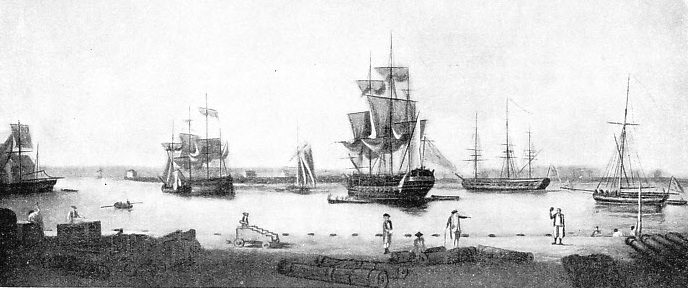
WARSHIPS OF THE ROYAL NAVY fitting out at Portsmouth in the time of Nelson. The mutinies at Spithead and the Nore in 1797 were proof of the poor treatment men received. The Admiralty finally realized this and conditions were ameliorated. This contemporary print gives an excellent idea of the scene in Nelson’s time at the famous naval base. A comparison with Portsmouth Naval Dockyard to-
THE most interesting aspect of naval warfare is not the sight of fire and smoke, nor the boom and crash of guns and shells -
It has been well said that strategy breaks down only when the rival fleets meet in battle and that it is practicable to enforce a nation’s determination by silent, persistent naval pressure. Of this we have an excellent example during the war of 1914-
All this has a close reference to the battle of the Nile, because principles are immutable. Ships may change from sail to steam, yet humanity and problems of naval warfare alter but little. Still more entertaining is this Nile drama because the two antagonists were men of small physical stature, yet giants in their respective professions. Each knew his own separate job to perfection, and they are regarded as the two most outstanding personalities of their period.
By the end of the seventeenth century the sailing ship had reached a state of development which altered but little till the eighteenth century’s close. Standardization had been pushed even beyond the limits of good reasoning, and a period had set in that allowed little room for originality. Individual thinking was discouraged, and this applied to the realm of art as well as to the design and rig of ships alike. For a long period, also, it applied to tactics. Not till Great Britain was willing to learn from the French in two particulars -
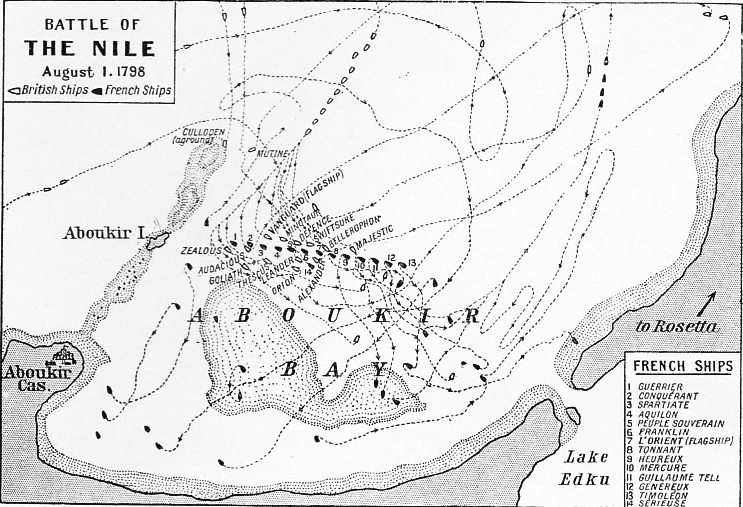
POSITIONS OF THE RIVAL FLEETS at the battle of the Nile are indicated on this diagram. The French ships are shown in black and numbered to correspond with the key inset. The British fleet, shown in white, entered the bay in line ahead. Dotted lines and arrows indicate how they moved up, in shoal-
The blind adherence to fighting instructions had caused English officers to believe it was better to fight and lose a battle according to the approved system, than to win by breaking the letter of the law. It needed Hawke to smash through such uninspired servitude, and Rodney to give shape to the new ideas.
The English man-
If it is asked how it was that Nelson’s ships succeeded, the answer is that this was the age of seamanship. Seamanship involves such details as getting the best out of sails, trimming sheets, careful steering, knowing how much way a vessel will carry, heaving the lead smartly and anchoring correctly in confined waters. Eighteenth-
The year 1797 was, however, one of the blackest in the history of the Royal Navy. In spite of the victorious battle of Cape St. Vincent in 1797, confidence at home received an unpleasant shock from the mutinies at Spithead and the Nore. Yet the men had a most just grievance. Pay had not been increased since the time of Charles II, though everything else since that period had risen 50 per cent, and no attention had been paid to their representations. Finally the Admiralty realized that the men’s claim was just.
Vain Dream of Oriental Empire
Such was the loyalty towards Nelson that no discontent ever occurred in any of Nelson’s ships. On the contrary, when he was appointed to the Theseus, whose crew had been mutineers, he soon found a chit of paper on the quarter-
Thus, when this Nile campaign began, not all the disappointments and hard going could impair that devotion which means so much to a leader. The times were anxious. Great Britain had evacuated the Mediterranean, and circumstances had laid heavy duties on the Navy. It had dominated the Dutch fleet off Tessel, the Spanish fleet in Cadiz and the French fleet in Brest. Further, it had to be ready to send a force for preventing an invasion of Ireland, and thwarting French privateers.
While France was immensely strong on land, the French and Spanish fleets were by now of inferior fighting efficiency; and the British blockade, having confined the French fleet within Brest, had weakened the Gallic naval spirit. The problem for the impatient and irate Napoleon was how to strike a serious blow at England. He saw a solution by the direct method of invasion -
But Napoleon failed at first to view the project in a seamanlike manner. Such a landing would be extremely risky unless France had command of the sea. There are few things more helpless than ships full of soldiers making a passage, and they are at the mercy of an armed squadron. The threat of such a landing raised considerable alarm among the British and, while the Mediterranean remained a French lake, a large naval fleet was kept in home waters prepared to defeat Napoleon’s venture.
By the beginning of 1798 Napoleon saw his error, and abandoned his plan in favour of an undertaking scarcely less ambitious but likely to have the same effect. His mind turned eastward, and he pictured for himself a vast oriental empire beginning with Egypt, comprising also Turkey, and ending only with India. Having once landed in Egypt and conquered it, his road to India would be clear. Thus the richest treasure house in the world, the country that was beginning to make England wealthy through the East India Company, was to fall into Bonaparte’s hands. Such a plan implied a direct attack against the greatest part of British trade, prosperity, shipping and national prestige.
Wisely he wrapped this idea in secrecy while the spring of 1798 was spent working out details for Egypt’s seizure. To screen his intention from our eyes, the invasion rumour was still allowed to be promulgated in England, while the Spanish fleet was to show enough activity to keep Lord St. Vincent with his ships in the neighbourhood of Cadiz. The basic error of Napoleon will manifest itself later, but so far he was acting on sound principles, for the French still retained command of the Mediterranean, and the expedition of 35,000 troops should be able to cross from Toulon to Egypt in safety. He himself remained in Paris until May 3, and they were all to leave Toulon five days later. That port to day is France’s great southern naval base, with a wide roadstead, dockyard, arsenal and quays that recall Portsmouth or Devonport. Overlooked from seawards and the surrounding mountains, it would be impossible for all these preparations to be made without their being observed. When news of such activity came to the British Government they became anxious.
The situation seemed so obscure that St. Vincent -
He counted forty-
The French expedition was to have started on May 8, but, after delay by bad weather, it left on May 19, Thus, by the time Nelson had refitted, taken in fresh water and returned towards Toulon, he found the harbour empty. This delay, however, had enabled him to get his reinforcements, but where the enemy had gone he could only guess.
An Elusive Enemy
Napoleon’s ships on June 9 were off Malta, which surrendered. The French fleet then set sail on June 18 eastward to get a landfall off Crete before altering course south-
We now come to a phase of singular interest where modem conditions of steamship traffic, wireless, fast scouts, and aeroplanes would have brought about a quick climax. The two rival fleets were converging towards the eastern Mediterranean basin long before a Suez Canal outlet had ever been contemplated. Almost any hour they must sight one another, yet neither was aware of the other’s position. To-
But inevitably, if slowly, fate kept drawing them together. On June 27, when off Crete, Bonaparte learnt from a frigate that Nelson had called at Naples ten days before. Bonaparte turned south to make a landfall west of Alexandria, and doubtless suffered some uneasiness as to whether he would encounter the British admiral before the disembarkation could be completed. But luck certainly was with Napoleon, and dead against Nelson. For Nelson arrived off Alexandria on June 28, only to observe with bitter dismay that the French were not there after all. Completely baffled, he got under way again and next day began a sweep of the eastern Mediterranean, coasting along Syria, and then finally turning-
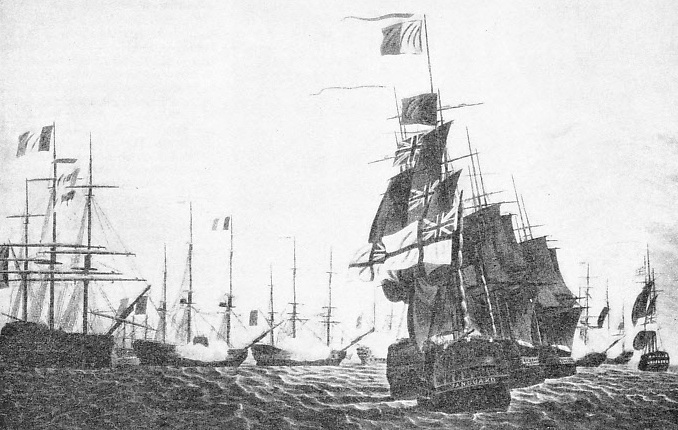
THE ATTACK AT SUNSET. In the foreground is Nelson's flagship, the Vanguard, with colours flying. Nelson sighted the French fleet in Aboukir Bay on the afternoon of August I, 1793. The British ships moved up into tactical positions, and fire was opened at 6.28 pm, shortly before darkness fell. By midnight the victory had been won.
Napoleon’s army marched south from Alexandria. The Mamelukes (Egyptian mounted soldiers) were defeated at the battle of the Pyramids on July 21. Four days later Napoleon entered Cairo, and then he completed the conquest of Lower Egypt. As to the fleet, Vice Admiral Brueys was given the choice of three courses. He could go across to Corfu, enter Alexandria harbour, or anchor in Aboukir Bay. He decided on the last alternative.
The French army in Egypt needed more and more supplies and reinforcements as time went on. These had to be brought across the Mediterranean from France through the gateway of Alexandria. The first essential, therefore, was the guaranteed safety of the sea route; yet Napoleon, with all his military genius, and Brueys, with all his naval experience, failed to realize the essential necessity of obtaining command of the Mediterranean. They knew that Nelson was not far away, they must have inferred that the British fleet was able to stop all means of marine communications and to blockade Alexandria. It might therefore have been supposed that Brueys would have been ordered to seek out Nelson and defeat him. Instead of this, however, the French admiral anchored his fleet to the southeast of Aboukir Island.
Meanwhile Nelson, irritated and bewildered, was searching the eastern Mediterranean. “I cannot to this moment learn, beyond vague conjecture, where the French fleet are gone to,” he remarked. Finally, after he had completed the circle at Sicily, there was nothing left save to begin again. He had reached Syracuse on July 19, and on July 24 sailed off towards the Egyptian coast. After a week at sea he sighted the French fleet at 1 pm of August 1 lying at anchor, but not till about five hours later did the battle begin.
During the whole of his pursuit up and down the Mediterranean, Nelson wherever practicable used to summon his captains on board the Vanguard and explain to them his intentions. On the eve of this battle of the Nile -
Attacked at Anchor
The most likely attack was against his van, yet he assumed this would be protected by the shoals to the north-
When Nelson that summer afternoon gazed across the waters he saw thirteen capital ships, which matched his own strength, though he had also a 50-
Brueys’ fleet in Aboukir Bay lay head to wind, every ship to a single anchor with springs on the cables ready for slipping and getting under way quickly. Yet they never moved, and part of the crew were busy ashore, getting fresh water. Although Brueys at 3 pm made the signal to prepare for battle, and endeavoured with his brigs to entice the British advanced ships on to the shoals off Aboukir Island, the French Commander-
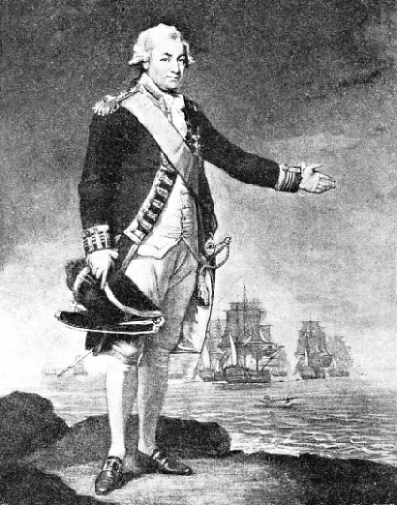
JOHN JERVIS, EARL OF ST. VINCENT, earned his title from his victory over the Spanish fleet on February 14, 1797, off Cape St. Vincent, Portugal. Born in 1735, this officer was a stern disciplinarian throughout his naval career. Although his strictness was unpopular, Lord St. Vincent introduced many reforms and increased the efficiency of the Navy to a marked degree. He was First Lord of the Admiralty in 1799-
On the contrary, at 4 pm Sir Horatio ordered his fleet to make preparations for anchoring by the stern. Then he intended to attack the enemy’s van and centre. This he would do in such a manner that part of the British fleet, having crossed Brueys’ van, would be on the south or landward side of the French line, while part would be on the northern or seaward side, as far down the line as Brueys’ flagship Orient, which was the seventh vessel. Nelson’s tactics were to concentrate an onslaught on the enemy’s windward half. This notion of bringing a superiority of weight against part of the rival’s force was to be used in principle some years later at Trafalgar.
At the battle of the Nile each of seven French battleships was to have a British man-
None of Nelson's ships, save the Swiftsure, carried a chart of the bay, and she had a rough sketch recently obtained out of a prize. A pilot would have been worth his weight in gold at that moment. When Nelson at 5.30 pm formed his fleet in line-
Concentration Tactics
By cautious sounding the Zealous found a way inside the shoals, and the Goliath followed across the French van, pouring a raking fire into the Guerrier, head of the enemy’s line. The second enemy ship was the Conquerant, on whose port quarter the Goliath now brought up by letting go her anchor from the stern. The Zealous had likewise anchored on the Guerrier’s port bow. HMS Orion also crossed the Guerner’s bows but then anchored head to wind abaft the beam of the Peuple Souverain, the enemy’s fifth ship. The Orion had also sunk the French frigate Seneuse. Next came HMS Audacious, which brought up on the Conquerant’s port bow, while HMS Theseus anchored by the stern almost abreast of Brueys’ third ship, the Spartiate. Thus five British ships were placed on the inner side of their opposite numbers. On the outer side of this line Nelson in the Vanguard brought up on the Spartiate’s star-
Of the remainder, HMS Culloden (Captain Troubridge) unfortunately had got aground and never took part in the battle. HMS Swiftsure (which had been sent the previous day to reconnoitre with the Alexander and the Leander) did not join up till after the engagement had begun, but she anchored abreast of the enemy’s sixth ship, the Franklin, after 8 pm. The Leander on arrival also attacked the Franklin, and the Alexander, having come round the French rear, anchored so as to engage with her starboard side the Orient’s port quarter.
The firing opened at 6.28 pm, the sun being then on the horizon Half an hour later Egyptian darkness covered the sea. To furnish recognition lights, every British ship hoisted at her mizen peak about 7 pm four lanterns horizontally. The fight at once developed fiercely, for within the initial fifteen minutes the first two ships of the French line had been dismasted, and by 8.30 pm the third, fourth, and fifth had been taken as prizes. According to Nelson’s own statement, the Orient was on fire for seventy minutes, and at 10.5 p.m. blew up with a shock that was felt in all the other vessels.
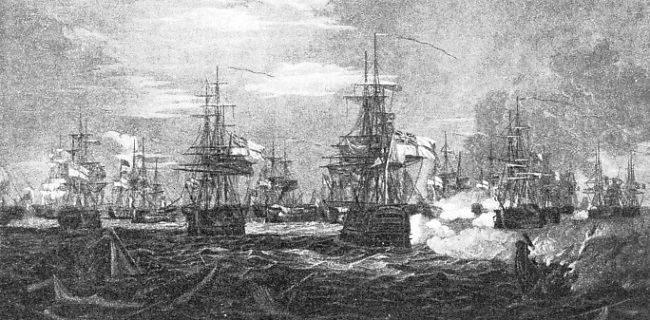
AT THE START Of THE BATTLE ten British ships engaged eight French ships. Five of Nelson’s ships were inshore and five were to seaward of the French line. By midnight the Tonnant was the only French vessel of the eight still defiant. There were five more enemy battleships in the rear, and by dawn only four of the thirteen, including the Tonnant, were still in action. The Guillaume Tell and the Genereux escaped by noon on August 2, and the Timoleon ran ashore. On August 3 the Tonnant lowered her ensign and her survivors set her on fire.
There is something so full of crude contrast in this nocturnal battle, with its red-
Rout of the French Fleet
The Timoleon ran herself ashore, the Tonnant was a wreck, but still lay at anchor with colours flying on August 3, when she finally lowered her ensign and her survivors set her on fire. Thus out of the thirteen line-
In such circumstances as these and at such close range, Nelson’s fleet could not expect to emerge scathless. It had suffered considerable damage, especially to masts and rigging. The Bellerophon, by her proximity to the French flagship, Orient, had been most severely damaged. She lost all three masts, and her hull also showed signs of injuries all too plainly. On one occasion Nelson had remarked, “Now had we taken ten sail, and allowed the eleventh to escape when it had been possible to have got her, I could never have called it well done.” Therefore his high personal standard was not attained in Aboukir Bay because four of the enemy had eluded him. Of this second phase -
“I then pressed further towards the Rear; and had it pleased God that I had not been wounded and stone blind, there cannot be a doubt but that every ship would have been in our possession.” He had been struck early in the fight by a splinter above his right eye.
Only one of his ships was lost, but that happened long after the battle. He had sent the Leander (a “seventy-
One of the most powerful effects in all drama belongs to strong contrast, as in calm after raging storm, peace after battle. As soon as the victory was complete, Nelson sent orders through the fleet that every ship should make thanksgiving to Almighty God for the blessing on His Majesty’s arms. Then, after the din of battle, men blackened with smoke, deaf with gunnery, dishevelled and dirty with sweat and grime, stood bareheaded with their own officers and the French prisoners as well. People ashore marvelled at this sudden stillness, but those who had just come out of hell’s mouth understood.
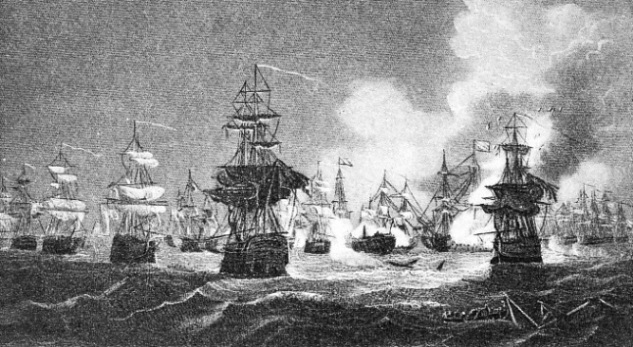
THE BLOWING UP OF THE FRENCH FLAGSHIP, the Orient, marked the climax of the battle of the Nile. She had been burning for seventy minutes when at 10.5 pm, with a terrific explosion, she was completely destroyed in a moment. HMS Bellerophon had engaged the Orient, and later HMS Alexander, with her starboard side, had engaged the Orient’s port quarter.
The secret of this triumphant success, so soon after the canker of mutiny had begun to impair the Royal Navy, was largely that of Nelson’s personality, apart from his professional skill. Yet in the same way as his officers and men regarded him, he respected and trusted them. “I had the happiness to command a Band of Brothers,” he wrote to Lord Howe.
“Nothing could withstand the squadron your lordship did me the honour to place under my command,” Nelson wrote to his superior, Lord St. Vincent, on August 3. “Their high state of discipline is well known to you, and with the judgment of the captains, together with their valour and that of the officers and men of every description, it was absolutely irresistible.”
“I cannot, my dear friend, express how great my joy is for the complete and glorious victory you have obtained over the French,” wrote Collingwood -
Well did Nelson deserve the peerage and life pension that were awarded him The letters quoted clearly indicate the sense of relief that Nelson had defeated Napoleon, and in the twentieth century it is difficult to apprehend how terrible the sound of Bonaparte’s name was to our forefathers. If the laudations should suggest exaggeration, they have been justified by others “The fatal engagement of Aboukir”, stated a distinguished French writer, “ruined all our hopes; it prevented us from receiving the remainder of the forces which were destined for us . . . it was no longer possible for us to dream of giving the English any uneasiness in India.”
Napoleon’s grandiose idea had been negatived in a manner that stunned him India had been preserved from this ambitious modern Alexander by a night’s victory in the Mediterranean.
Blockade of the Egyptian Coast
Nelson knew, or guessed, that Bombay was the real objective of the French. Therefore, not content with having won a naval fight, he immediately afterwards sent one of his officers overland, and by the Tigris and sea, with letters to the Governor of Bombay. Had the battle of the Nile ended differently, had Bonaparte been able to finish his project and conquer India, the present prosperity of the British nation, the strength of its Merchant and Royal Navies and much of the wealth for which the City of London now stands, would have been impossible.
It was the middle of August when Napoleon learned of the crushing defeat to his fleet that he had considered as ancillary to, rather than the basis of, his army. He perceived the mistake and realized that with the sea’s command passing to the English his army was now in the air, unsupported, resting on nothing. The moral effect on his troops, virtually prisoners, can be imagined. Internationally a coalition in Europe against France could not fail to follow.
Nelson’s fleet could not remain indefinitely off the Egyptian coast. All that would be required was to institute a blockade, and this had to be done by a few ships enforcing that condition which Nelson had just brought about. The door having been slammed, it needed only a guard to prevent the captives from breaking forth. Blockades, however, cannot be absolutely tight.
After the battle of Quiberon Bay in 1759 off the west coast of France, Hawke had come “swooping from the west”, but no fewer than nine French units managed to escape up the River Vilaine, and there they remained for months blockaded by a British squadron. One dark night at the beginning of 1761 several slipped out and evaded the blockade. The same thing happened off the Egyptian coast a few years later. Napoleon managed to escape in a frigate, landed on the south French coast, and before long he had begun again to plan an invasion of England.
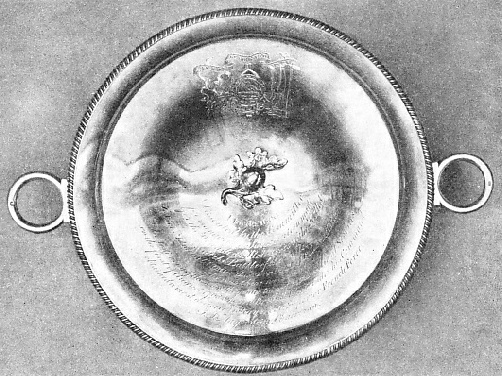
A SILVER DISH GIVEN TO NELSON after the battle of the Nile. This interesting relic is now in the possession of Lloyd’s. The inscription reads : “Lloyds 1800. Presented by the Committee for managing a Subscription made for the Wounded & Relatives of the Killed at the Battle of the Nile to Vice Admiral Lord Nelson & Duke of Bronti, K.B., &c., &c., &c., who was there wounded. As a testimony of the sense they entertain of his Brilliant Services on the first of August 1793, when a British Fleet under his Command obtained a most decisive Victory over a Superior French Force. J. J. Angerstein. Chairman.”
You can read more on “The Battle of Trafalgar”, “Decisive Naval Actions” and “From Tudor to Victorian Times” on this website.